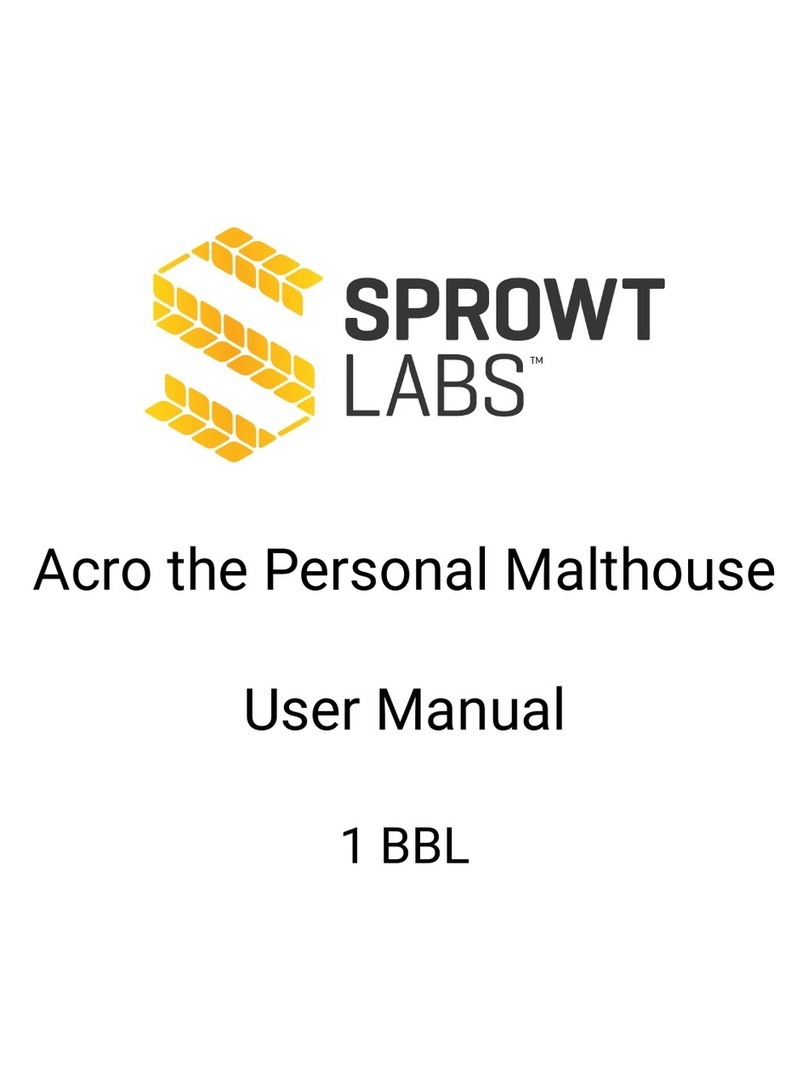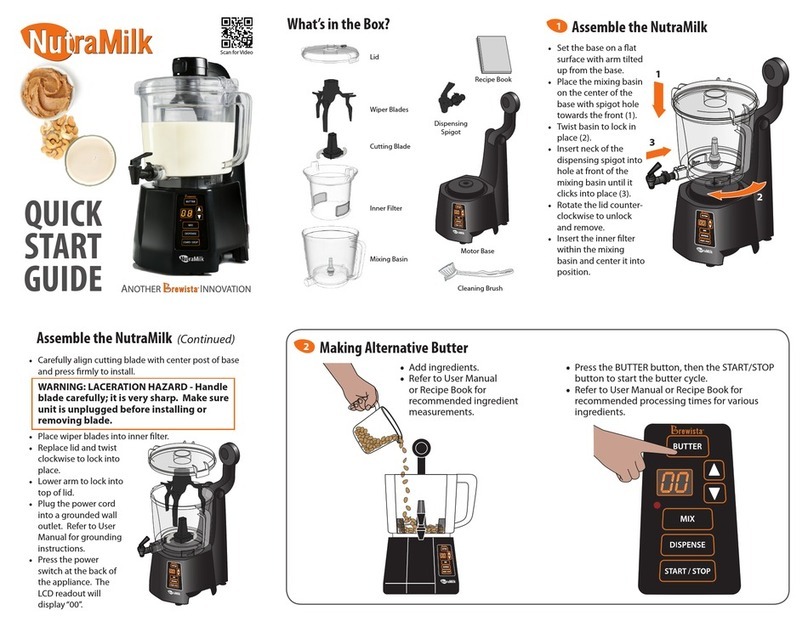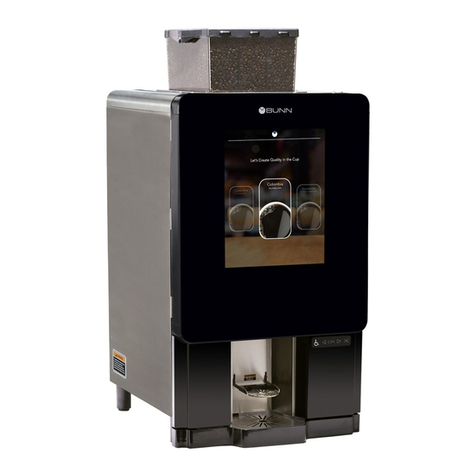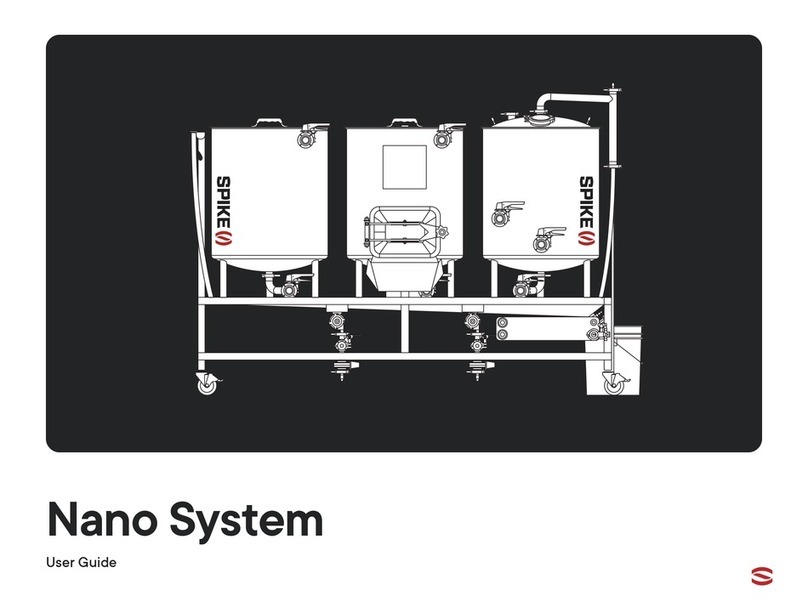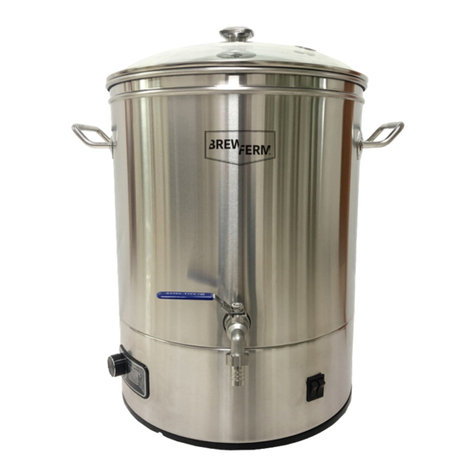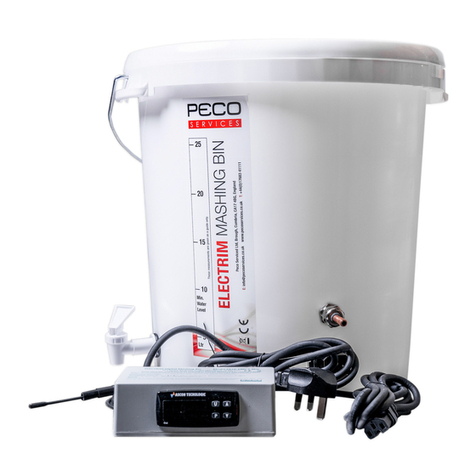FastBrewing & WineMaking FastFerment 7.9G User manual

USER MANUAL
EN
7.9G
EN
Congratulations on your FastFerment Purchase!
Now you will be able to make the best beer, wine, cider or mead in the comfort of your own
home with the least amount of eort.Thank you for allowing us to help!
We have solid Customer Service so if you have any questions or
concerns, please allow us to help before you look elsewhere.
NEED HELP?
Step 1: Check out our website - Go to www.FastBrewing.com
Step 2: Watch ourVideos - Click on“Products”->“Product Videos”
Step 3: Read FastFerment FAQ - Click on “FAQs”->“FastFerment FAQs
Step 4: If you can’t nd what you’re looking for, send an email to
Info@FastBrewing.com or call us 800 549 5763
EN
1
FIRST TIP:
Never, Ever
Rest the FastFerment
on the Collection Ball
FLOOR
Standard Kit Contents ............................................................................... 3
Description of Parts .................................................................................. 4
FastFerment Starter Kits ........................................................................... 5
Setting up the Wall Mounts ....................................................................... 6
FastFerment Set Up - Cleaning & Sanitizing ................................................ 7
FastFerment Set Up - Taping ...................................................................... 8
FastFerment Set Up - Assembly .................................................................. 9
Simple Steps for Using FastFerment ......................................................... 10
Making Wine with the FastFerment ......................................................... 11
Making Wine with the FastFerment Option 1............................................ 12 - 14
Making Wine with the FastFerment Option 2 ........................................... 14 - 16
Homebrewing with a FastFerment .......................................................... 17
Homebrewing with a FastFerment - Malt Extract Syrup ............................. 18 - 20
Homebrewing with a FastFerment - Brew in a Bag .................................... 20 - 22
Homebrewing with a FastFerment - All Grain ............................................ 22 - 24
Top 5 Frequently Asked Questions ............................................................ 25 - 26
Hyrdrometer Readings ............................................................................ 27 - 28
Harvesting Yeast ..................................................................................... 29
7.9 Gallon FastFerment Accessories........................................................... 30
Other FastBrewing Products .................................................................... 31 - 32
FastBrewing Company Contact Information ............................................. 35
Table of Contents
EN
1) Conical Fermenter Body - 1
2) Collection Ball - 1
3) Left and RightWall Mounts - 2
4) 1”UnionValve - 1
5) 6”ScrewTop - 1
6) 3 Piece Airlock - 1
7) Rubber Grommet - 1
8) Hose Barb - 1
9) TeonTape - 1
7.9G (30L) Standard Kit Contents
10) Hose - 1
11)Thermowell - 1
12) 6” Hollow Rubber Gasket - 1
13)Wall Mount Bolts andWashers - 4 each
14) Hose Clamp - 1
15) UnionValve Fittings for Collection Ball & Hose Barb - 4
(3 pieces will be attached to the UnionValve)
16) Spare O’Ring for UnionValve - 1
17) Side Insert Bolts - 2
* Wall Mounts are located in bottom of box
* Starter Kits have additional parts
(this will be inside
the 6” Screw Top)
Need Spare Parts?
“Find a Retailer”page at:
www.FastBrewing.com
EN
1
3
Parts List

Description of Parts
1) Conical Fermenter Body - Main vessel for fermentation
2) Collection Ball - Small vessel to collect trub and sediment
3) Left and Right Wall Mounts - Mounts to hold the 7.9G FastFerment on the wall
4) 1” Union Valve -Valve to allow contents to ow into the Collection Ball
5) 6” Screw Top - Lid for the top of the Fermenter Body
6) 3-Piece Airlock - Allows CO to escape during primary and secondary fermentation
7) Rubber Grommet - Holds and seals the Airlock in the Lid
8) Hose Barb - Located in the Valve; attaches the Valve to the Hose
9) Teon Tape - Seals o threads on the Thermowell, Conical Fermenter Body and Collection Ball
10) Hose - Fills bottles or kegs from the open Union Valve
11) Thermowell - Holds a thermometer in place; plugs the Conical Fermenter Body
12) 6” Hollow Rubber Gasket - Seals the Conical Fermenter Body and the Lid
13) Wall Mount Bolts and Washers - Used to attach the Wall Mounts to the wall
14) Hose Clamp - Closes o the Hose when lling when needed
15) Union Valve Fittings for Collection Ball & Hose Barb - Interchangeable ttings to attach the
Union Valve to the Hose Barb or Collection Ball
16) Spare O’Ring for Union Valve - Replacement part for Union Valve
17) Side Insert Bolts - Holds the Conical Fermenter Body in the Wall Mounts
Contact us if you have any parts questions:
Info@FastBrewing.com
EN
Need Spare Parts?
“Find a Retailer” page at:
www.FastBrewing.com
4
FastFerment
Double Lever Corker
Star San 4oz Bottle
2 - 2 oz PBW Packages
Triple Scale Hydrometer
Plastic Spoon
Bottle Brush
Corks
Dual Scale Liquid Crystal
Thermometer
FastFerment Starter Kits
FastFerment Starter Kits incude everything one needs to start brewing!
Standard Beer Starter Kit FastFerment
Double Lever Capper
Star San 4oz Bottle
Triple Scale Hydrometer
Plastic Spoon
Bottle Brush
Dual Scale Liquid Crystal
Thermometer
Standard Wine Starter Kit
EN
5
Cleanliness should be the foremost concern of a homebrewer or winemaker. Providing good
growing conditions for the yeast in the wort or must also provides good growing conditions for
other microorganisms, especially wild yeast and bacteria. Cleanliness to prevent
contamination must be maintained throughout every stage of the brewing/winemaking
process.
Setting Up the Wall Mounts
RIGHT SIDE
(when looking at
FastFerment)
LEFT SIDE
(when looking at
FastFerment)
The lip of the Wall Mount (where the hole for the screws are) go to the OUTSIDE.
Step 1: Determine the area where you will mount the FastFerment by locating two
adjacent wall studs. Wall studs are typically 16” (40.64 cm) apart, which is ideal
for the mounting system. You will need a stud for each Wall Mount.
Use the stand accessory if mounting is not possible.
Step 2: For homebrewers who are bottling, mark a spot on each stud at 40” (101.6 cm)
in height. If you are kegging - mark spots at 52” (132.08 cm) in height.
Ensure the marks are exactly the same height to keep the unit level for mounting.
Step 3: Line the top of each Wall Mount up with the line drawn on the stud. Make marks
in the 4 bolt holes in the Wall Mount for where you will screw in the Wall Mount
Bolts. Drill pilot holes and mount both Wall Mounts.
Step 4: Hand tighten the two Side Insert Bolts into the side of the FastFerment until they
are snug. Do not over-tighten.
Step 5: Before you put a full FastFerment in the Wall Mounts, ll the FastFerment 1/2
way and place in the Wall Mounts before lling the whole thing to ensure you’ve
mounted them correctly. Once that’s determined, your Wall Mounts are ready to
use.
IMPORTANT NOTE: Screwing the side insert bolts too tight will pop the insert out and ruin the wall mounting capabilities.
Wall Mounts are for 7.9G (30L) FastFerment ONLY. Use only the provided Wall Mounts
to hang your FastFerment. We cannot guarantee other parts that we haven’t provided.
There’s a Wall Mount video - www.FastBrewing.com
EN
6
Cleanliness should be the foremost concern of a homebrewer or winemaker. Providing good
growing conditions for the yeast in the wort or must also provides good growing conditions for
other microorganisms, especially wild yeast and bacteria. Cleanliness to prevent
contamination must be maintained throughout every stage of the brewing/winemaking
process.
FastFerment parts have not been cleaned prior to shipping.
PBW (Powdered Brewery Wash) is gentle, alkali-based cleanser used to remove dust and debris
before brewing and stubborn deposits after brewing. Soak all parts with PBW and use a soft
cloth to assist. Rinse o with water if it is a high quality source.
FastFerment Set Up - Cleaning & Sanitizing
Soak with PBW and Rinse
Our Recommendations for Cleaning & Sanitizing Include:
Spray with StarSan Sanitizer
Use sanitizer at a rate of 1oz (30ml) in 5 US gallons (18.9L) of water. Apply by spray or soak
each part with a contact time of at least 5 minutes. Empty or drain the parts and let air dry.
All parts and equipment should be reassembled wet after being sanitized to minimize
contamination. DO NOT RINSE SANITIZER OFF.
There’s a Cleaning video - www.FastBrewing.com
EN
7

Take the supplied Teflon Tape and wrap the threads in the same direction as the
threads rotate (clockwise direction when looking at the thread - see pictures below)
Apply Teflon Tape to:
1.Threads at the bottom of the Conical Fermenter Body (white to grey)
2.Threads on the Collection Ball (white to grey)
3.Threads on the Thermowell (brass to white)
ALERT: Be very careful with the threads - if you cross thread, the warranty
is no longer valid on the damaged parts.
Always tape in a clockwise direction
There’s an Assembly video - www.FastBrewing.com
NOTE: You might need 6-10 layers of tape.
If any connection leaks during a leak test, it requires more layers of tape.
EN
8
FastFerment Set Up - Taping
Step 1: Carefully without cross threading, thread the taped thermowell into the hole
If you cross thread the thermowell, the warranty is void.
Step 2: Attach the solid end of the Union Valve to the Conical Fermenter Body. *Only
screw the valve to where it touches the conical, don’t overtighten or
this could break the threads o and won’t be under warranty.
Step 3: Screw on one set of Union Valve Fittings to the Collection Ball
Step 4: Attach the Hose to the Hose Barb
Step 5: Attach the Collection Ball to the Union Valve and open the Union Valve
Step 6: Insert the Grommet into the hole on the top of the 6” Screw Top
Step 7: Insert the Airlock into the Grommet
Step 8: Place the completed FastFerment into the Wall Mounts using the Side Insert Bolts
or the stand.
FastFerment Set Up - Assembly
Important!
EN
Step 10: If leak test produces no leaks, sanitize and begin your rst batch by screwing on the
6” Screw Top with the Hollow Rubber Gasket to completed the closed system.
Step 9: Do a leak test by lling the FastFerment with water to ensure that
everything seals properly. We suggest leaving it for a minimum of 5-6
hours. If there is a leak, add a few extra layers of tape.
9
Pop the handle o the valve Place the knobs in the matching divits Tighten the valve in
clockwise rotation
Step 1
Step 2
Step 3
Tighten the Valve
Simple Steps for Using FastFerment
Pour ingredients
into FastFerment
Screw on lid
with airlock
Allow time for primary
fermentation with valve open
When primary fermentation
is done, close the valve Remove the collection ball Dump, clean & sanitize
the collection ball
Or, harvest the yeast to reuse Reattach the collection ball Open the valve
Allow time for secondary
fermentation with valve open When primary fermentation
is done, turn o valve Remove the collection ball
Bottle or keg & enjoy!
1. 2. 3.
4. 5. 6.
7. 8. 9.
10. 11. 12.
Attach the lling hose Adjust the hose clamp13. 14. 15.
EN
10
Suggested Equipment for WineMaking
FastFerment 7.9 Gallon (30L) Conical Fermenter
FastFerment SS Hop Filter (FastBrewing Accessory)
FastWasher12 BottleWasher
FastRack12 Rack & Tray
PBW (or similar cleaner)
StarSan Sanitizer (or similar sanitizer) & Spray Bottle
Bottle Brush (long handled nylon bristle brush)
Thermometer (FastBrewing Accessory)
Hydrometer
Graduated Cylinder (optional – for sampling Starting Gravity)
Plastic Stirring Spoon (Food Grade Plastic)
Corks
Corker
Wine Bottles
Degasser
Making Wine with FastFerment
It is recommended that if you are using any
grape skins, wood chips or other avoring items
larger than a 1/4”(0.64cm) diameter, you should
use our Hop Filter in the FastFerment
during fermentation for easy retrieval.
EN
11

There are hundreds of wine kits so the following guidelines are recommendations to be used
with a standard wine kit. We advise that you adjust dates for waiting based on your hydrometer
readings and the time duration that the kit provides you with. Please ensure that you read all
instructions before beginning to guarantee maximum eciency and best results.
Winemaking – Option 1:
Day 1: Primary Fermentation
Step 1: Clean and assemble FastFerment
Step 2: Perform a leak test (use water) and when successful, sanitize all equipment
Step 3: Pour the contents of the bag into the FastFerment and add water to desired volume
Step 4: Slowly sprinkle the packet of Bentonite, stirring constantly
Step 5: Put some water in the bag, swirl it around and dump it into the FastFerment
Step 6: Add 1.1G (4 l) of water, adjusting the temperature so that the inside temperature
once full is between 68-77°F (20-25° C). At this point you have an option to add a
mash bag to add more avor if the kit provides one
Step 7: Stir vigorously
Step 8: Check the specic gravity of must and record
Step 9: Add the yeast as per instructions
Step 10: Screw the lid on the FastFerment with the Grommet and Airlock installed
Step 11: Let primary fermentation occur (approx. 7 days)
Primary Fermentation is complete when the Specic Gravity is around 1.030.
The number of days suggested is a general guideline.
Standard Kit Contents ............................................................................... 3
Description of Parts .................................................................................. 4
FastFerment Starter Kits ........................................................................... 5
Setting up the Wall Mounts ....................................................................... 6
FastFerment Set Up - Cleaning & Sanitizing ................................................ 7
FastFerment Set Up - Taping ...................................................................... 8
FastFerment Set Up - Assembly .................................................................. 9
Simple Steps for Using FastFerment ......................................................... 10
Making Wine with the FastFerment ......................................................... 11
Making Wine with the FastFerment Option 1............................................ 12 - 14
Making Wine with the FastFerment Option 2 ........................................... 14 - 16
Homebrewing with a FastFerment .......................................................... 17
Homebrewing with a FastFerment - Malt Extract Syrup ............................. 18 - 20
Homebrewing with a FastFerment - Brew in a Bag .................................... 20 - 22
Homebrewing with a FastFerment - All Grain ............................................ 22 - 24
Top 5 Frequently Asked Questions ............................................................ 25 - 26
Hyrdrometer Readings ............................................................................ 27 - 28
Harvesting Yeast ..................................................................................... 29
7.9 Gallon FastFerment Accessories........................................................... 30
Other FastBrewing Products .................................................................... 31 - 32
FastBrewing Company Contact Information ............................................. 35
Filling Hose Attachment
There’s a Wine Making video - www.FastBrewing.com
Note - ”Filling Hose Attachment” refers to the Hose on the Hose Barb with the
Union Fitting and the Hose Clamp (see picture below - 5 pieces total)
EN
12
WineMaking Instructions - Option 1
Winemaking – Option 1 Continued:
Days 7-10: Secondary Fermentation
Step 12: Once primary fermentation is complete, close the Union Valve, remove and empty
the contents of the Collection Ball
Step 13: Clean and sanitize the Collection Ball before reattaching (at this point you should
also remove the mash bag if you are using one)
Step 14: Reattach the Collection Ball
Step 15: Re-open the Union Valve
Step 16: Leave FastFerment in a warm, dark area for the duration of secondary fermentation
(approx. 12 days)
Days 20-22: Degassing and Stabilizing
Step 17: Take a hydrometer reading.The S.G should be 0.995 or lower for secondary
fermentation to be complete. If the S.G is higher, wait a few more days
Day 24-32: Clearing
Step 18: It is time to clear the wine by adding the last ning agents. Refer to your kit for
clearing instructions
Step 19: Degas - using either a plastic stir spoon or degassing equipment, degas wine
vigorously for 2 - 5 mins. You can repeat this step 2- 4 times a day over the next
2 days or just once really well will suce
Step 20: Add the Metabisulphite and the Potassium Sorbate packages and stir vigorously
At this point you have the option of continuing the next few steps
on the same day or waiting 5-7 days
There’s a Wine Making video - www.FastBrewing.com
EN
13
Winemaking – Option 1 Continued:
Day 33-40: Filtering and Bottling
Step 23: Clean and sanitize wine bottles and Filling Hose Attachment
Step 24: Remove collection ball and attach sanitized Filling Hose Attachment
Step 25: Make sure the Hose Clamp is closed.Then open the Union Valve to start
lling wine into bottles. Try to minimize the exposure to the air. Fill the bottles so
that the wine is about 0.4”(1cm) from the bottom of the cork
Step 26: Keep wine bottles upright for 1 - 3 days
Step 27: Keep your wine in a temperature controlled environment, out of direct sunlight for
suggested amount of months prior to consuming
Step 28: Clean and sanitize your equipment
Step 29: Get ready for your next batch using FastFerment!
Wine Making Instructions - Option 2, Even Easier
Winemaking – Option 2:
Day 1: Primary and Secondary Fermentation
Step 1: Clean and assemble FastFerment
Step 2: Perform a leak test (use water) and when successful, sanitize all equipment
Step 3: Pour the contents of the bag into the FastFerment and add water to desired volume
Step 4: Slowly sprinkle the packet of Bentonite, stirring constantly
Step 5: Put some water in the bag, swirl it around and dump into FastFerment
Step 6: Adjust the temperature so that the inside temperature once full is between 68-77°F
(20-25° C). At this point you have an option to add a mash bag to add more avor
if the kit provides one.
There’s a Wine Making video - www.FastBrewing.com
Option 2 reduces the workload even more and has been proven successful for years
in Wine-on-Premise locations by the Inventor. They are his recommendations only.
EN
14
It is important that the wine is thoroughly degassed.
The S.G must be between 0.990 and 0.995
Days 20 - 22: Degassing and Stabilizing
Step 12: Take a hydrometer reading.The S.G must be 0.995 or lower for secondary
fermentation to be complete. If the S.G is higher, wait a few more days
Day 24 - 32: Clearing
Step 13: It is time to clear the wine by adding the last ning agents. Refer to your kit for
clearing instructions
Step 14: Degas - using either a plastic stir spoon or degassing equipment, degas wine
vigorously for 2-5 mins. You can repeat this step 2-4 times a day over the next 2 days
or once really well is good enough
Step 15: Add the Metabisulphite and the Potassium Sorbate packages and stir vigorously
Winemaking – Option 2 Continued:
Step 7: Stir vigorously
Step 8: Check the specic gravity of the must
Step 9: Sprinkle in the yeast - do not stir
Step 10: Put the lid on FastFerment
Step 11: Do not open or touch for the duration of primary and secondary fermentation
(approx. 20-22 days)
If you choose to clear your wine on the same day as your degassing and
stabilizing, degas wine again for another 5 minutes. If you waited to clear wine,
reseal lid and let it sit for 6 days
There’s a Wine Making video - www.FastBrewing.com
EN
15

Cleanliness should be the foremost concern of a homebrewer or winemaker. Providing good
growing conditions for the yeast in the wort or must also provides good growing conditions for
other microorganisms, especially wild yeast and bacteria. Cleanliness to prevent
contamination must be maintained throughout every stage of the brewing/winemaking
process.
Winemaking – Option 2 Continued:
Days 33-40: Filtering and Bottling
Step 17: Clean and sanitize the wine bottles
Step 18: Rinse and sanitize the Filling Hose (recommended)
Step 19: Remove the Collection Ball
Step 20: Attach the sanitized Filling Hose Attachment
Step 21: Make sure the Hose Clamp is closed.Then open the Union Valve to start lling wine
into bottles. Try to minimize the exposure to the air. Fill the bottles so that the wine
is about 0.4”(1cm) from the bottom of the cork
Step 22: Keep wine bottles upright for 1 - 3 days
Step 23: Store wine in a temperature controlled environment, out of direct sunlight for
suggested amount of months prior to consuming
Step 24: Clean and sanitize all equipment
Step 25: Get ready for your next batch using FastFerment!
Check to see if wine is clear - if it is not clear, it is not ready to bottle.
There is no need to remove the Collection Ball until this point. It is designed to hold
sediment with an approximate foot of clearance from the wine.
There’s a Wine Making video - www.FastBrewing.com
EN
16
Cleanliness should be the foremost concern of a homebrewer or winemaker. Providing good
growing conditions for the yeast in the wort or must also provides good growing conditions for
other microorganisms, especially wild yeast and bacteria. Cleanliness to prevent
contamination must be maintained throughout every stage of the brewing/winemaking
process.
FastFerment 7.9 Gallon (30L) Conical Fermenter
FastFerment SS Hop Filter (FastBrewing accessory)
FastWasher24 BottleWasher
FastRack24 Rack & Tray
PBW (or another cleaner)
StarSan (or another sanitizer)
Thermometer
Hydrometer
Graduated Cylinder (optional – for sampling S.G)
Bottle Brush (long handled nylon bristle brush)
Plastic Stirring Spoon (Food Grade Plastic)
Bottle Caps (check if your kit provides them)
Capper
Large Boiling pot
Wort Chiller (or ice to put in a bathtub/large sink)
0.5G (200ml) container (to prepare yeast)
Mashtun (optional)
Brew-in-a-Bag (optional)
Pen and Notepad
Homebrewing with FastFerment
It is recommended that if you are using any
grape skins, wood chips or other avoring items
larger than a 1/4”(0.64cm) diameter, you should
use our Hop Filter in the FastFerment
during fermentation for easy retrieval.
Suggested Equipment for Homebrewing
EN
17
Homebrewing Instructions
Please read the instructions entirely before starting on your brew day to ensure maximum
eciency and the best results.We also advise you to adjust dates and measurements according
to your specic recipe.The three most important things to keep in mind every time you
brew are: Cleanliness, Preparation and Good Record Keeping.
Homebrewing– Option 1: Malt Extract Syrup
Day 1 - Brew Day (Follow Instructions on Ingredient Kit):
Step 1: Clean and assemble FastFerment
Step 2: Perform a leak test (use water) and when successful, sanitize all equipment
Step 3: Gather ingredients purchased from your favorite homebrew shop
Step 4: Boil suggested amount of water
Step 5: Once boiling, remove pot from the heat and stir in the malt extract syrup, make sure
it doesn’t collect at the bottom (stir until completely dissolved)
Step 6: Once dissolved, return liquid to boil for a total of 1 hour
Step 7: Once liquid reaches a rolling boil, proceed to adding hops by following instructions
given to you (within boiling hour)
NEED EXTRA HELP? We have great resources:
Step 1: Check out our website - Go to www.FastBrewing.com
Step 2: Watch our Videos - Click on“Products” ->“Product Videos”
Step 3: Read FastFerment FAQs - Click on “FAQs”->“FastFerment FAQs
Step 4: If you can’t nd what you’re looking for, send an email to
Info@FastBrewing.com or call us 800 549 5763
There’s a Brewing video - www.FastBrewing.com
EN
18
Homebrewing– Option 1: Malt Extract Syrup Continued
Step 8: Once the hour is up, it is time to chill the wort. Attach chiller to a cold-water source
and cool wort. Cool until wort has reached pitching temperature 65-90°F (18-32°C)
Step 9: Take a sample of the wort and record a hydrometer reading
Step 10: Re-hydrate yeast
Step 11: Add wort into FastFerment and then add yeast
Fermentation:
Step 12: Seal the lid tight and place FastFerment on the Wall Mounts or in the optional stand
accessory. Leave undisturbed for the duration of primary fermentation (time varies
depending on the type of beer)
Step 13: Once primary fermentation is complete, close the Union Valve, remove and empty
the contents of the Collection Ball
Step 14: Sanitize and clean the Collection Ball before reattaching (at this point you should
also remove the mash bag if you are using one)
Step 15: After re-attaching the Collection Ball, re-open the Union Valve
Step 16: Allow brew to sit for remainder of secondary fermentation (times vary)
Step 17: When secondary fermentation is complete, turn o the Union Valve and remove the
Collection Ball to discard the contents or harvest the yeast (See page 31)
Step 18: Your beer is now ready to bottle!
You have the option of sealing the lid and gently shaking the conical to
aerate the wort for the yeast to grow or stir vigorously
Depending on the type of beer, choose a location that has a stable temperature.
If brewing Ale, room temperature is recommended 65-70°F (18-21°C)
There is the option to harvest the yeast for reuse. Check out page 30-31 for Tips!
There’s a Brewing video - www.FastBrewing.com
EN
19

Homebrewing– Option 1: Malt Extract Syrup Continued
Bottling/Kegging Day:
Step 19: Wash, sanitize all beer bottles and place in a FastRack24. Also sanitize Hose,
Hose Barb and Hose Clamp
Step 20: Prepare priming solution
Step 21: Add priming solution to FastFerment and stir gently
Step 22: Wait for sediment to settle for 15 - 30 minutes before proceeding
Step 23: Attach the Filling Hose Attachment
Step 24: Put Hose Clamp on the Hose and make sure it is closed. Then open the Union Valve to
start lling beer into bottles.Try to minimize the exposure to the air. Fill the bottles
so that the wine is about 1”(2.54cm) from the top and cap
Step 25: Clean FastFerment and other equipment
Step 26: Place bottles in a room-temperature area and let them sit to allow carbonation
to take place
Step 27: Wait 2 - 3 weeks. Cool beers and crack one open with a friend!
Homebrewing– Option 2: Brew-in-a-Bag
Brew Day (Follow Instructions on Ingredient Kit):
Step 1: Clean and assemble FastFerment
Step 2: Perform a leak test (use water) and when successful, sanitize all equipment
Step 3: Gather ingredients purchased from your favorite homebrew shop
Step 4: Line boiling pot with a grain bag
Step 5: Fill boiling pot with water (you will be mashing with the full volume of water)
Step 6: Heat your water to 1° more than the target mash temperature of the recipe to allow
for cooling caused by the grain addition
There’s a Brewing video - www.FastBrewing.com
EN
A typical 5-gallon batch requires two cases (48) of 12oz (355ml) bottles for bottling
20
Homebrewing– Option 2: Brew-in-a-Bag Continued
Step 7: Add grain to pot and stir the mash very gently until the grains are submerged and
wet (if the temperature has cooled signicantly during the previous step, add more
heat to bring wort back to the desired temperature)
Step 8: Put the lid on and leave it according to the mash schedule
Step 9: After the waiting period, lift the bag from the wort slowly and allow it to drain
(hold it close to the beer’s surface to eliminate splashing and introducing air)
Step 10: Bring wort to a boil
Step 11: Keep on a rolling boil for 1 hour. Begin adding hops according to provided schedule
Step 12: Once the hour is up, it is time to chill the wort. Attach chiller to a cold water source
and cool wort. Cool until wort has reached pitching temperature 65-90°F (18-32°C)
Step 13: Take hydrometer reading and record
Step 14: Re - hydrate yeast
Step 15: Add wort into FastFerment and then add yeast
Fermentation:
Step 16: Seal the lid tight and place FastFerment on Wall Mounts or the optional Stand
accessory. Leave undisturbed for duration of primary fermentation (time varies
depending on the type of beer)
Step 17: Once primary fermentation is complete, close the Union Valve, remove and empty
the contents of the Collection Ball
Step 18: Sanitize and clean the Collection Ball before reattaching (at this point you should
also remove the mash bag if you are using one)
Depending on the type of beer, choose a location that has a stable temperature.
If brewing Ale, room temperature is ne 65-70°F (18-21°C)
There is the option to harvest the yeast for reuse. Check out page 30-31 for Tips!
There’s a Brewing video - www.FastBrewing.com
EN
21
Homebrewing– Option 2: Brew-in-a-Bag Continued
Step 19: After re-attaching the Collection Ball, re-open the Union Valve
Step 20: Allow brew to sit for the remainder of secondary fermentation (times vary)
Step 21: When secondary fermentation is complete, turn o the Union Valve and remove the
Collection Ball to discard the contents
Step 22: Your beer is now ready to bottle!
Bottling/Kegging Day:
Step 23: Wash, sanitize all beer bottles and place in a FastRack24. Also sanitize Hose,
Hose Barb and Hose Clamp
Step 24: Prepare priming solution
Step 25: Add priming solution to FastFerment and stir gently
Step 26: Wait for sediment to settle for 15-30 minutes before proceeding
Step 27: Attach the Filling Hose Attachment and the Filling Hose
Step 28: Siphon beer into bottles leaving 1”(2.54cm) of space from the top and the cap
Step 29: Clean FastFerment and other equipment
Step 30: Let bottles sit in a room-temperature area and allow carbonation to take place
Step 31: Wait 2 - 3 weeks. Cool Beers and crack one open with a friend!
Homebrewing– Option 3: All- Grain
Brew Day (Follow Instructions on Ingredient Kit):
Step 1: Clean and assemble FastFerment
Step 2: Perform a leak test (use water) and when successful, sanitize all equipment
Step 3: Gather ingredients purchased from your favorite homebrew shop
Step 4: In a Mashtun, steep your milled grain in hot water 152oF (67oC)
Step 5: Steep for one hour and pour into a boiling pot
You may re-add this wort through the Mashtun to get out more sugar
or run new water through sugar and pour into boiling pot
There’s a Brewing video - www.FastBrewing.com
EN
22
Homebrewing– Option 3: All- Grain Continued
Brew Day (Follow Instructions on Ingredient Kit):
Step 6: Take a sample of the wort and record a hydrometer reading
Step 7: Bring wort to a boil
Step 8: Keep on a rolling boil for 1 hour then begin adding hops according to brew schedule
Step 9: Once the hour is up, it is time to chill the wort. Attach chiller to a cold water source
and cool the wort. Cool until wort reaches pitching temp. 65-90°F (18-32 °C)
Step 10: Take hydrometer reading and record
Step 11: Re-hydrate yeast
Step 12: Add wort into FastFerment and then add yeast
Fermentation:
Step 13: Seal the lid tight and place FastFerment on the Wall Mounts or the optional stand
accessory. (Leave undisturbed for duration of primary fermentation.Time varies
depending on type of beer)
Step 14: Once primary fermentation is complete, close the Union Valve, remove and empty
the contents of the Collection Ball
Step 15: Sanitize and clean the Collection Ball before reattaching (at this point you should
also remove the mash bag if you are using one)
You have the option of sealing the lid and gently shaking the conical to aerate
the wort for the yeast to grow or stirring vigorously
Depending on the type of beer, choose a location that has a stable temperature.
If brewing Ale - room temperature is good 65-70°F (18-21°C)
There is the option to harvest the yeast for reuse. Check out page 30-31 for Tips!
There’s a Brewing video - www.FastBrewing.com
EN
23

Homebrewing– Option 3: All- Grain Continued
Step 16: After re-attaching the Collection Ball, re-open the Union Valve
Step 17: Allow brew to sit for remainder of secondary fermentation (times vary)
Step 18: When secondary fermentation is complete, turn o the Union Valve and remove the
Collection Ball and discard the contents
Step 19: Your beer is now ready to bottle
Bottling/Kegging Day:
Step 20: Wash, sanitize all beer bottles and place in a FastRack24. Also sanitize Hose,
Hose Barb and Hose Clamp
Step 21: Prepare priming solution
Step 22: Add priming solution to FastFerment and stir gently
Step 23: Wait for sediment to settle for 15-30 minutes before proceeding
Step 24: Attach the Filling Hose Attachment
Step 25: Put the Hose Clamp on the Hose and make sure it is closed. Then open the Union Valve
to start lling beer into bottles.Try to minimize the exposure to the air. Fill the
bottles so that the beer is about 1”(2.54cm) from the top and cap
Step 26: Clean FastFerment and other equipment
Step 27: Place bottles in a room-temperature area and let them sit to allow carbonation to
take place
A typical 5-gallon batch requires two cases (48) of 12oz (355ml) bottles for bottling
There’s a Brewing video - www.FastBrewing.com
EN
24
FastFerment FAQs are regularly updated on our website
Go To - www.FastBrewing.com
1. Valve is Leaking Through the Middle - IT’S NOT BROKEN!
The valve needs to be tighened. Over time, the middle of the valve may come loose and needs
to be tightened using the handle as a wrench. Follow these instructions:
Pop the handle o the valve Place the knobs in the matching divits
Tighten the valve in
clockwise rotation To clean the valve, use the same instructions &
remove the middle by rotating counter-clockwise
Step 1
Step 2
Step 3
EN
25
Top 5 Frequently Asked Questions (FAQs)
Click FAQs FastFerment
Top 5 Frequently Asked Questions (FAQs) Continued
2. The Valve is Clogging
The valve clogs if there are large hops or peices of avoring funneling down into the
Collection Ball. The best way to ensure this doesn’t happen is to use our Hop Filter for
everything inside and agitate the conical every so often, it will not clog.
3. Is the Valve Open or Closed During Fermentation?
The valve should always be open during Fermentation to allow the trub or sediment fall into
the Collection Ball for easy removal. The FastFerment is a closed system so the valve can be
left open at all times.
4. Can I set the FastFerment down on the Collection Ball since it’s Flat?
NOWAY! It is not meant to sit on the collection ball and will 100% fall over, break and
probably mess your entire oor.You MUST use the wall mounts or a stand when using
the FastFerment.
5. WhatTemperatures can the FastFerment Handle?
Your FastFerment can handle 176°F (80°C) safely. If you go above this temperatures with any
of the parts, we cannot guarantee them.
.
FastFerment FAQs are regularly updated on our website
www.FastBrewing.com
Click FAQs FastFerment
EN
26
Hydrometer Readings
A hydrometer is an instrument used to measure the specic gravity of liquids. Measuring
gravity is the same as measuring the density.
We use it to determine how much fermentable sugar the wort or must contains. Sugar is more
dense than water, so a solution such as wort with lots of sugars will have a higher reading.The
more alcohol content in the liquid, the lower the reading will be.
You should always try and take your reading using a sample of your liquid that is around 68°F
(20°C). If the liquid is 41°F (5°C) higher, add 0.001 and similarly, if it’s 41°F (5°C) lower, take o
0.001.
Why Use A Hydrometer?
Taking a hydrometer reading allows you to accurately test whether fermentation is complete.
A hydrometer reading (taken before mixing with yeast) will also help you at the end when you
are interested in calculating your alcohol content level.
Starting/Original Gravity (OG)
All beer and wine vary on their starting gravity. For wine, an average OG should be
1.070 to 1.090. For beer, the OG starts in the 1.030-1.060 range.
The rst reading should be at the start of fermentation.
Ensure your sample is 68°F (20° C). If not, wait until the sample is closer to this
temperature for the most accurate reading.
EN
27

Hydrometer Readings Continued
Taking Hydrometer Readings
Step 1: Begin by pouring some wort or must into a hydrometer test jar leaving 2”(5.08cm)
of space from the top for when inserting the hydrometer.
Step 2: Insert your hydrometer into the test jar, giving it a little swirl to remove any bubbles
from sticking to the sides. When recording your reading, ensure that you are at eye
level and recording the lower of the two levels (see picture below).
Step 3: Take a second reading after primary fermentation
Step 4: Take a third reading at the end of secondary fermentation
Finish Gravity (FG)
The FG Should be 0.990 (for dry wines) to 1.005 (for sweet wines). A typical beer will have a
FG at 1.012.
Calculating Alcohol Content
To calculate the alcohol content, subtract the original gravity (OG) by the nish gravity (FG) and
multiply that number by 131 (OG – FG * 131).
Homebrewing– Option 2: Brew-in-a-Bag
Brew Day (Follow Instructions on Ingredient Kit):
Step 1: Clean and assemble FastFerment
Step 2: Perform a leak test (use water) and when successful, sanitize all equipment
Step 3: Gather ingredients purchased from your favorite homebrew shop
Step 4: Line boiling pot with a grain bag
Step 5: Fill boiling pot with water (you will be mashing with the full volume of water)
Step 6: Heat your water to 1° more than the target mash temperature of the recipe to allow
for cooling caused by the grain addition
EN
28
Homebrewing– Option 2: Brew-in-a-Bag Continued
Step 7: Add grain to pot and stir the mash very gently until the grains are submerged and
wet (if the temperature has cooled signicantly during the previous step, add more
heat to bring wort back to the desired temperature)
Step 8: Put the lid on and leave it according to the mash schedule
Step 9: After the waiting period, lift the bag from the wort slowly and allow it to drain
(hold it close to the beer’s surface to eliminate splashing and introducing air)
Step 10: Bring wort to a boil
Step 11: Keep on a rolling boil for 1 hour. Begin adding hops according to provided schedule
Step 12: Once the hour is up, it is time to chill the wort. Attach chiller to a cold water source
and cool wort. Cool until wort has reached pitching temperature 65-90°F (18-32°C)
Step 13: Take hydrometer reading and record
Step 14: Re - hydrate yeast
Step 15: Add wort into FastFerment and then add yeast
Fermentation:
Step 16: Seal the lid tight and place FastFerment on Wall Mounts or the optional Stand
accessory. Leave undisturbed for duration of primary fermentation (time varies
depending on the type of beer)
Step 17: Once primary fermentation is complete, close the Union Valve, remove and empty
the contents of the Collection Ball
Step 18: Sanitize and clean the Collection Ball before reattaching (at this point you should
also remove the mash bag if you are using one)
Harvesting Yeast
How to Harvest Yeast from FastFerment
Step 1: Attach the Collection Ball, open the Union Valve, add the wort and pitch the yeast
Step 2: Let fermentation start for 1 - 3 days
Step 3: As the trub settles over the rst few days of fermentation, it can be discarded by
cleaning out the Collection Ball.You should always wait 24 hours before switching
out the the Collection Ball again so everything can settle.Trub will be characterized
by a dark colour
Step 4: You should only change out the collection ball if the trub/sediment line is above the
Union Valve.Try not to waste any beer.
Step 5: Once most of the trub has been discarded, wait 6-12 days for primary fermentation
to be over. The Collection Ball should be lled with occulated and dormant yeast
ready to harvest
Step 6: Close the Union Valve and disconnect the Collection Ball
Step 7: Take the Collection Ball contents and put the rubber bung on tight to seal and
store in fridge or cold dark area. You should use this live yeast within 2-4 weeks of
harvesting maximum
Step 8: Sanitize the second the Collection Ball and reattach it to the FastFerment
Step 9: Open Union Valve to start secondary fermentation
Step 10: Small amounts of yeast and trub will continue to collect in Collection Ball.This
can all be discarded at the end of complete fermentation
Step 11: To reuse your harvested yeast, simply pitch into your next batch by pouring the
contents from the Collection Ball into the Conical Fermenter Vessel when it calls for
yeast
EN
*These are just our suggestions, please consult multiple sources*
29
Thermometer
7.9 FastFerment Accessories
Stand
Collection Ball Carrying Strap
Sample Port Insulated Jacket
Hop Filter
FastFerment accessories make it easier, and more enjoyable to make beer and wine.
Want Accessories?
“Find a Retailer”page at:
www.FastBrewing.com
EN
30
Tell Us
What you Want
to See!
14G FastFerment
EN
31
Stand Leg Extensions
Hop Filter
- Most aordable 14G conical fermenter available
- Built on the gold medal winning design of the 7.9G FastFerment
- Heavy Duty
+33%Thicker vessel & collection ball than the 7.9G FastFerment
+33%Thicker stand than the 7.9G FastFerment
+33% Larger valve than the 7.9G FastFerment
- Makes it easy to keg straight from the 14G FastFerment
- Assembles nto the stand included with the 14G FastFerment
-Works for both 7.9G & 14G FastFerments
-Works for dry hopping, oak chips, grapes skins & other avor infusions

3G FastFerment
FastWasher12 & FastWasher24 for FastRack12 & FastRack24
EN
32
Wash, sanitize, drain & store all of your bottles with the FastWasher12 and FastWasher24
and the FastRack12 and FastRack24
- Perfect for 1 & 2 Gallon batches & splitting 5G batches
-Yeast Collection in various size mason jars
- Comes with stand for easy storage
DIRECTIONS FOR USE:
Use as a nal acid rinse after removing all gross soil deposits with a good alkaline cleaner such as PBW.Use Star San HB at a rate of 1 oz in 5 gallons of water. Apply
by spray or soak with a contact time of at least 2 minutes. Empty or drain the vessel and let air dry. All parts and equipment should be reassembled wet after soak
to minimize contamination. Let air dry. (Local state health departments may require a potable water rinse after using all chemicals.)
MODE D'EMPLOI
Utiliser comme solution de rinçage nal à l'acide après avoir enlevé tous les dépôts desaletés importants avec un bon nettoyant alcalin comme PBW. Utiliser Star
San HB dilué à raison de 30 ml (1 oz) dans 19 litres (5 gallons) d'eau. Appliquer par pulvérisation outrempage avec un temps de contact d'au moins deux minutes.
Vider ou drainer la cuve et laisser sécher à l'air. Toutes les pièces et tout l'équipement devraient être réassemblésalors qu'ils sont encore mouillés après le trempage
pour minimiser la contamination. Laisser sécher à l'air. (Les services sanitaires locaux peuvent exiger un rinçage à l'eaupotable après l'utilisation de tout produit
chimique.)
FIRST AID
If in Eyes: Hold eye open and rinse slowly and gently with water for 15-20 minutes. Remove contact lenses, if present, after rst 5 minutes, then continue rinsing.
Call a Poison Control Center or doctor for treatment advice. If Swallowed: Call a Poison Control Center or doctor immediately for treatment advice. Have person
sip a glass of water if able to swallow. Do not induce vomiting unless told to do so by the Poison Control Center or doctor. Do not give anything by mouth to an
unconscious person. If on Skin or Clothing:Take o contiminated clothing. Rinse skin immediately with plenty of water for 15-20 minutes. Call a Poison Control Center
or doctor for treatment advice. If Inhaled: Move person to fresh air. If person is not breathing, call 911 or an ambulance, then give articial respiration, preferably
mouth-to-mouth, if possible. Call a Poison Control Center or doctor for treatment advice.
FIRST AID
En cas de contact avec les yeux : Garder les paupières écartées et rincer doucement et lentement avec de l’eau pendant 15 à 20 minutes. Enlever les lentilles de
contact, s’il y a lieu, après les 5premières minutes et continuer à rincer. Appeler un centre antipoison ou un médecin pour plus deconseils sur le traitement. En
cas d’ingestion : Appeler immédiatement un centre antipoison ou unmédecin pour obtenir des conseils sur le traitement. Faire boire à petites gorgées un verre
d’eau, si la personne peut avaler. Ne pas faire vomir, sauf avis contraire du centre antipoison ou du médecin. Nerien administrer par la bouche à une personne
inconsciente. En cas de contact avec la peau ou lesvêtements : Enlever tous les vêtements contaminés. Laver immédiatement la peau à grande eaudurant 15 à 20
minutes. Appelez un centre antipoison ou un médecin pour obtenir des conseils sur letraitement. En cas d’inhalation : Sortir la personne à l’air libre. Si elle ne
respire pas, appeler le 911 ou une ambulance, puis pratiquer la respiration articielle, de préférence le bouche-à-bouche, sipossible. Appeler un centre antipoison
ou un médecin pour obtenir des conseils sur le traitement.
Have the product container or label with you when calling to Poison Control Center or a doctor or going for treatment.You may also contact
1-800-535-5053 for emergency treatment information. NOTE TO PHYSICIAN: Probable mucosal damage may contraindicate the use of gastric
lavage.
Avoir le contenant ou l’étiquette du produit en main au moment d’appeler le centre antipoison ou un médecin, ou lorsqu’on veut se faire soigner.
Composer le 1 800 535-5053 pour obtenir des renseignements sur le traitement. NOTE AU MÉDECIN : Des dommages probables aux muqueuses
peuvent contre-indiquer l’utilisation du lavage gastrique.
DANGER: KEEP OUT OF REACH OF CHILDREN - Emergency telephone/TENIR HORS DE LA PORTÉE DES ENFANTS Numéro d'urgence:
Infotrac 1-800-535-5053
STARSAN HB
ACTIVE INGREDIENTS:
Dodecylbenzensulfonic Acid ..........................................................15%
Phosphoric Acid .............................................................................50%
Inert Ingredients ............................................................................35%
Total ..............................................................................100%
Phosphate content by weight percent as expressed as %P...............15.8%
Phosphate content expressed as grams P per ounce .......................6.5 gm/oz
INGRÉDIENTS ACTIFS :
Acide Dodécylbenzènesulfonique .....................................................15%
Acide Phosphorique ...........................................................................50%
Ingrédients inertes .............................................................................35%
Total ................................................................ .................100%
Teneur en phosphate, en pourcentage du poids, exprimée en % P.......15.8%
Teneur en phosphate, exprimée en grammes de P par once ................6.5 gm/oz
Manufactured by/Fabriqué par Five Star Chemicals & Supply,
Inc 4915 E 52nd Ave, Commerce City, CO 80022
P: (303) 287-0186 F: (303) 287-0391
33
LIMITATION OF LIABILITY
FullThrottle Parts Inc. and Axle Plastic Inc. shall not be liable for any liabilities, damages, costs,
claims, suits or actions resulting from any breach, violation, or non-performance of any
covenant, condition or agreement, whether in contract, tort, or any other action, resulting from
any damages of any nature, including, but not limited to, damages for any loss of use,time,
prots, savings, investment, or revenues to the extent that the same may be claimed at law for
the use and enjoyment of FastFerment or any accessories, parts or any other material aspects
associated with FastFerment.
LIMITATION OF LIABILITY
EN AUCUN CAS FullThrottle Parts Inc. OU Axle Plastic Inc. SERA-T-IL RESPONSABLE POUR N’IMPORTE QUELS DOMMAGES,
FRAIS, POURSUITES OU ACTIONS RÉSULTANTS DE VIOLATIONS QUELCONQUE OU D’UNE NON-EXÉCUTION D’UN ACCORD,
SOIT EN CONTRAT, TORT, OU AUTREMENT, RÉSULTANT DE DOMMAGES ACCIDENTELS, SPÉCIAUX, INDIRECTS OU PUNITIFS,
Y COMPRIS, MAIS SANS ÊTRE LIMITÉ, AUX DOMMAGES POURTOUTE PERTE D'UTILISATION, PERTE DETEMPS, OU PERTE DE
BÉNÉFICES, ÉCONOMIES, INVESTISSEMENTS ET REVENUS À LA PLEINE AMPLEUR QUI PUISSE ÊTRE RÉCLAMÉ PAR LE DROIT
POUR L'UTILISATION DU FastFerment OU SES ACCESSOIRES OU LES PIÈCES ASSOCIÉES AVEC LE FastFerment.
EN
34
Homebrewing– Option 3: All- Grain Continued
Brew Day (Follow Instructions on Ingredient Kit):
Step 6: Take a sample of the wort and record a hydrometer reading
Step 7: Bring wort to a boil
Step 8: Keep on a rolling boil for 1 hour then begin adding hops according to brew schedule
Step 9: Once the hour is up, it is time to chill the wort. Attach chiller to a cold water source
and cool the wort. Cool until wort reaches pitching temp. 65-90°F (18-32 °C)
Step 10: Take hydrometer reading and record
Step 11: Re-hydrate yeast
Step 12: Add wort into FastFerment and then add yeast
Fermentation:
Step 13: Seal the lid tight and place FastFerment on the Wall Mounts or the optional stand
accessory. (Leave undisturbed for duration of primary fermentation.Time varies
depending on type of beer)
Step 14: Once primary fermentation is complete, close the Union Valve, remove and empty
the contents of the Collection Ball
Step 15: Sanitize and clean the Collection Ball before reattaching (at this point you should
also remove the mash bag if you are using one)
Contact Information
FastBrewing & WineMaking
Unit 105, 264 Queens Quay W.
Toronto, ON, Canada
M5J 1B5
1 800 549 5763
Info@TheFastRack.ca
www.FastBrewing.com
We have a solid Customer Service so if you have any questions or
concerns, please allow us to help before you look elsewhere.
NEED HELP?
Step 1: Go www.FastBrewing.com
Step 2: Click on Product Videos
Step 3: Read FastFerment FAQ’s
Step 4: If you can’t nd what you’re
looking for, send an email to Info@FastBrewing.com
35
Table of contents
Popular Brewing System manuals by other brands
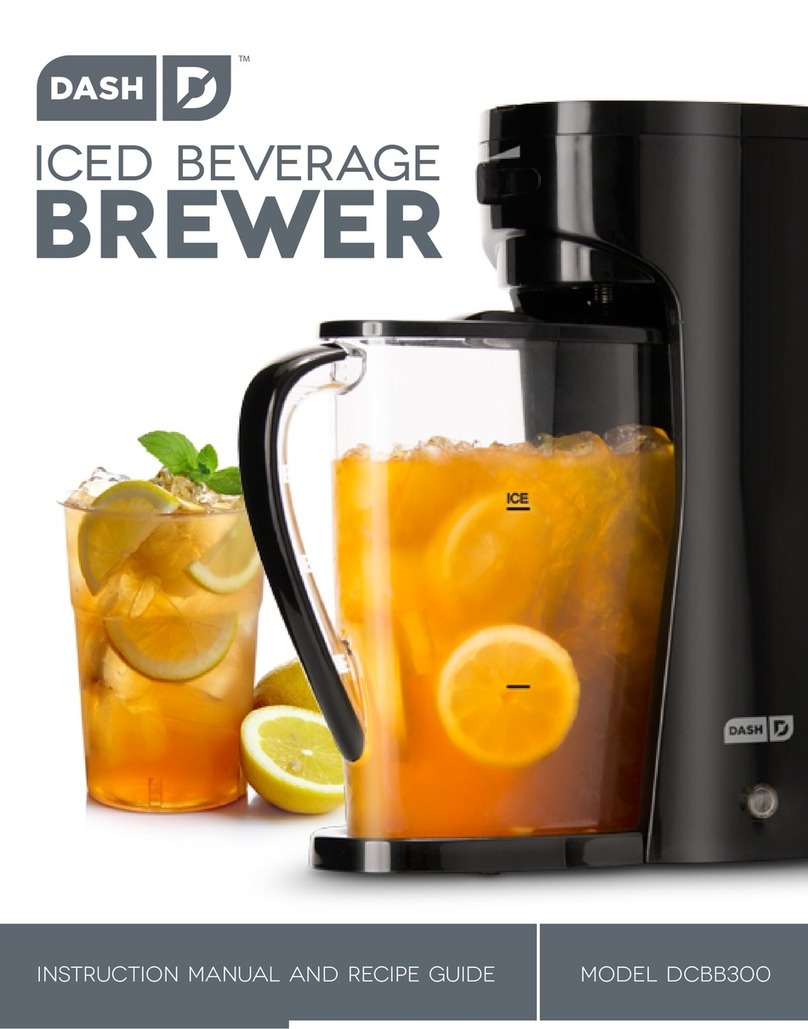
Dash
Dash DCBB300 Instruction manual and recipe guide

Franke
Franke Bkon Craft Brewer Operation manual
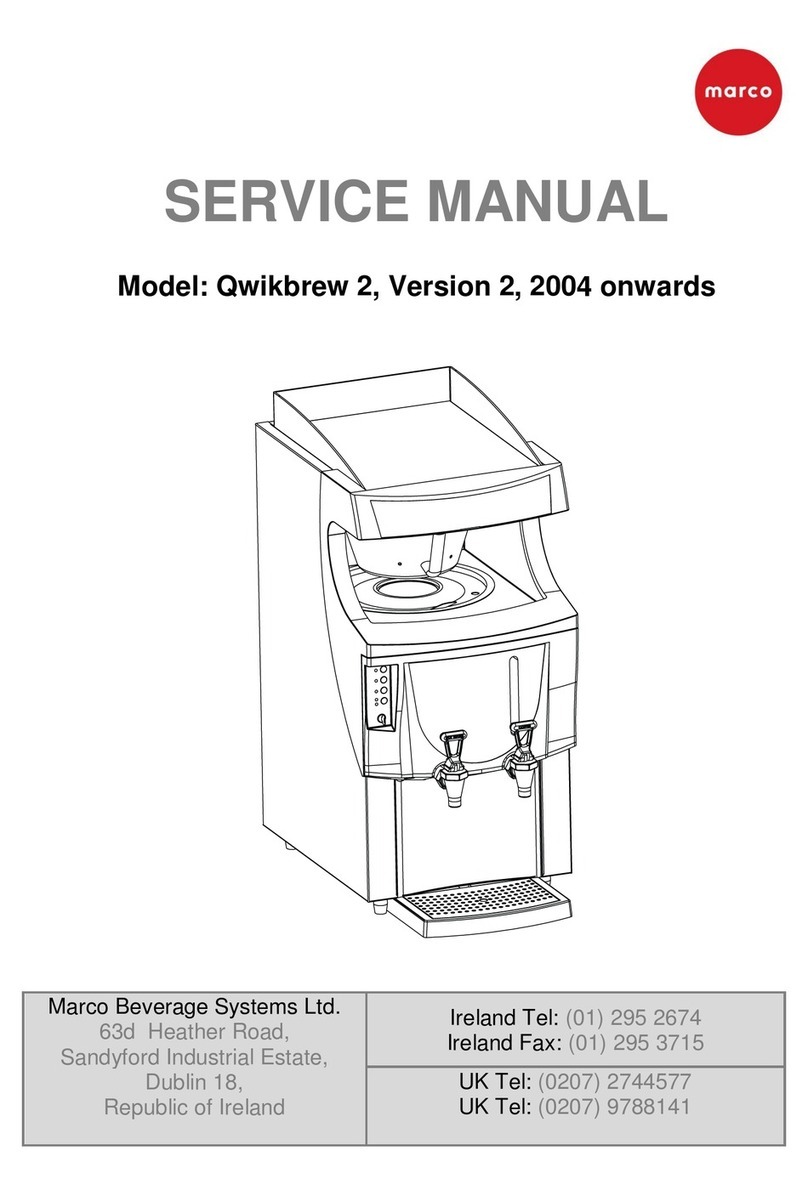
Marco
Marco Qwikbrew 2 Twin Service manual
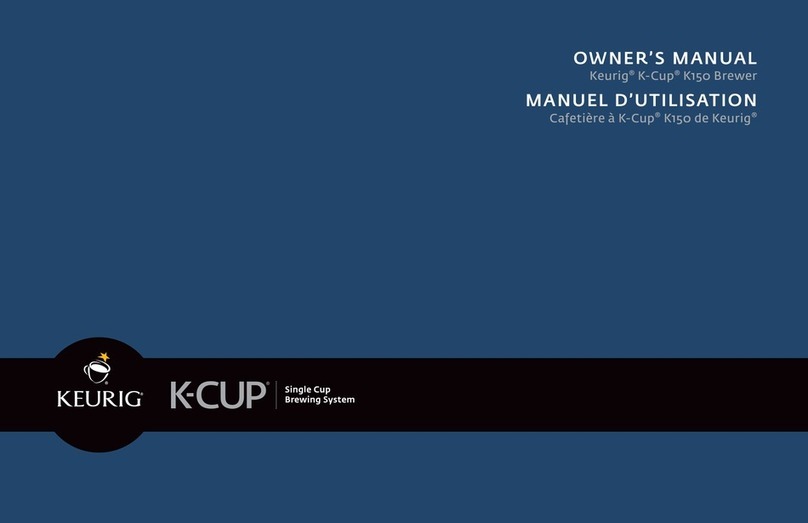
Keurig
Keurig K150 owner's manual
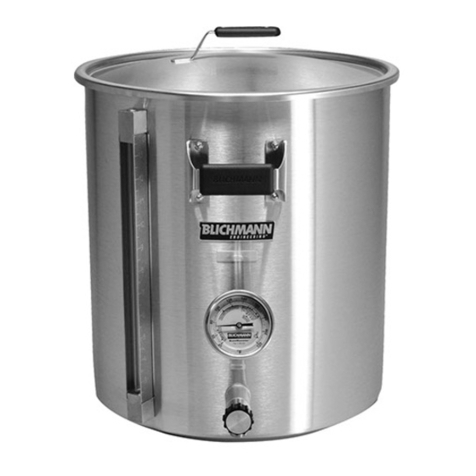
Blichmann Engineering
Blichmann Engineering BoilerMaker G2 Assembly operation maintenance
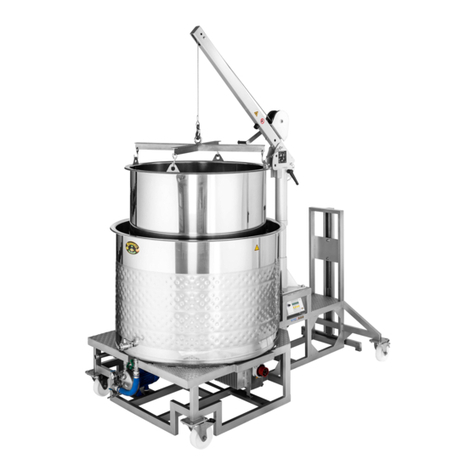
Speidel
Speidel Braumeister 200 L operating manual
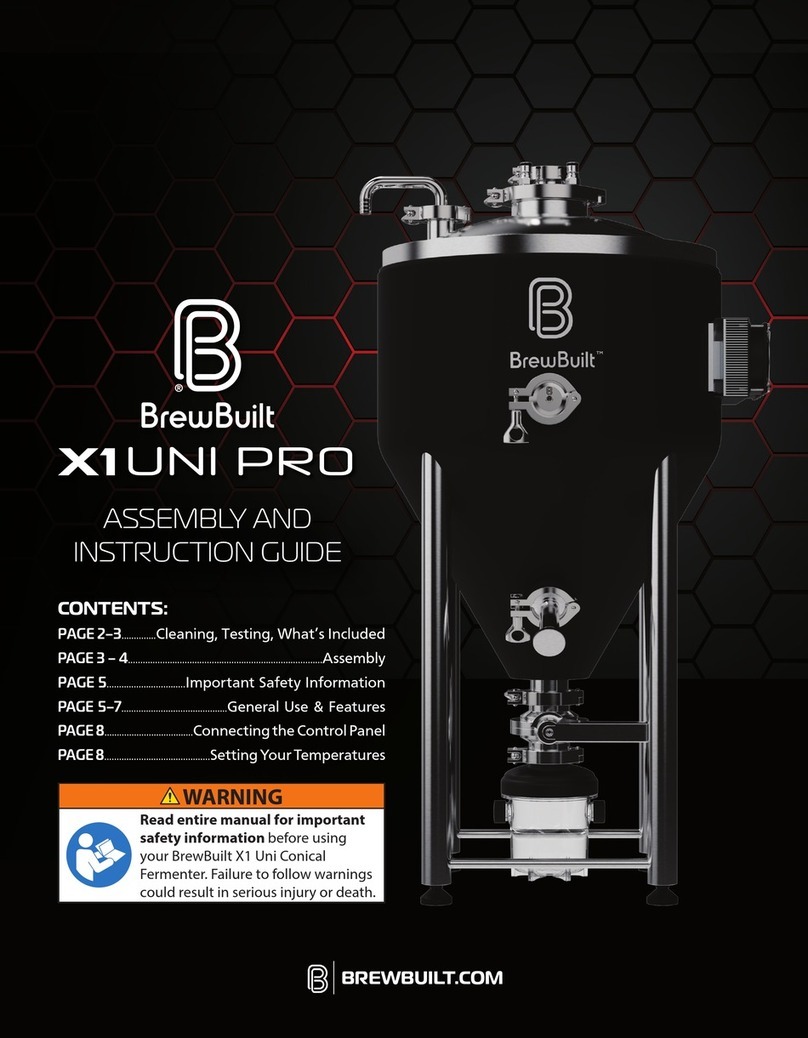
BrewBuilt
BrewBuilt X1 UNI PRO Assembly and Instruction Guide
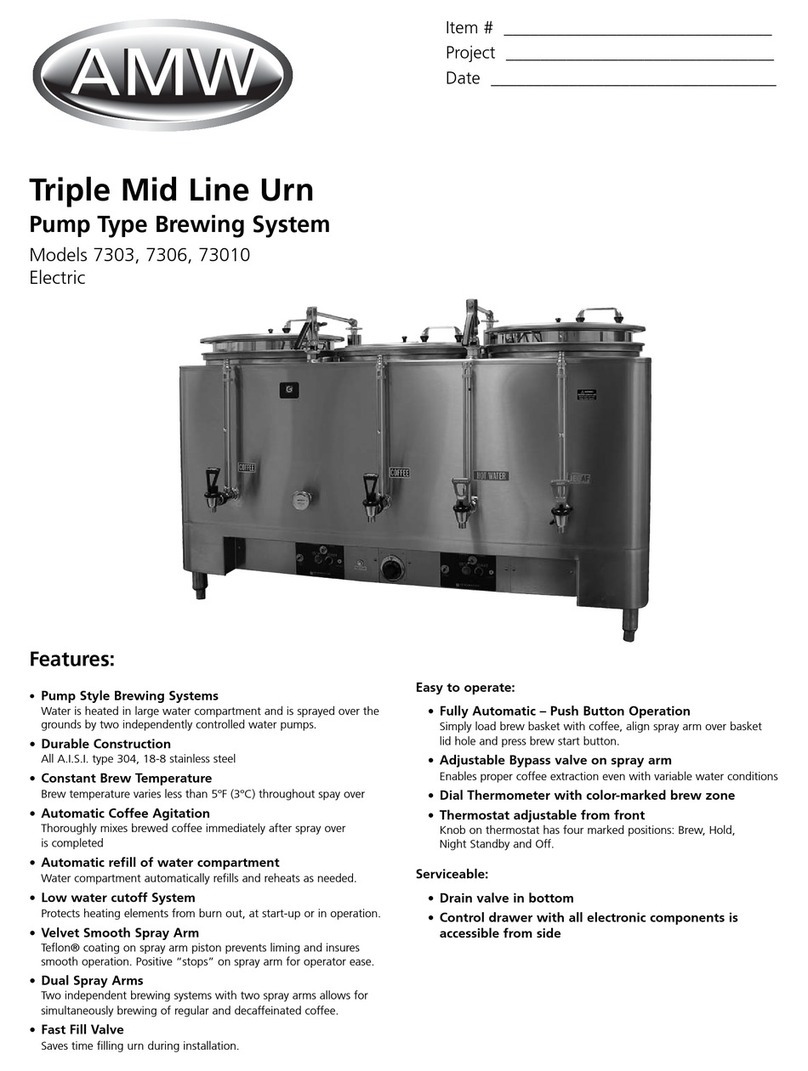
AMW
AMW 73010 Specification sheet

VINCI
VINCI NITRO COLD BREW instructions
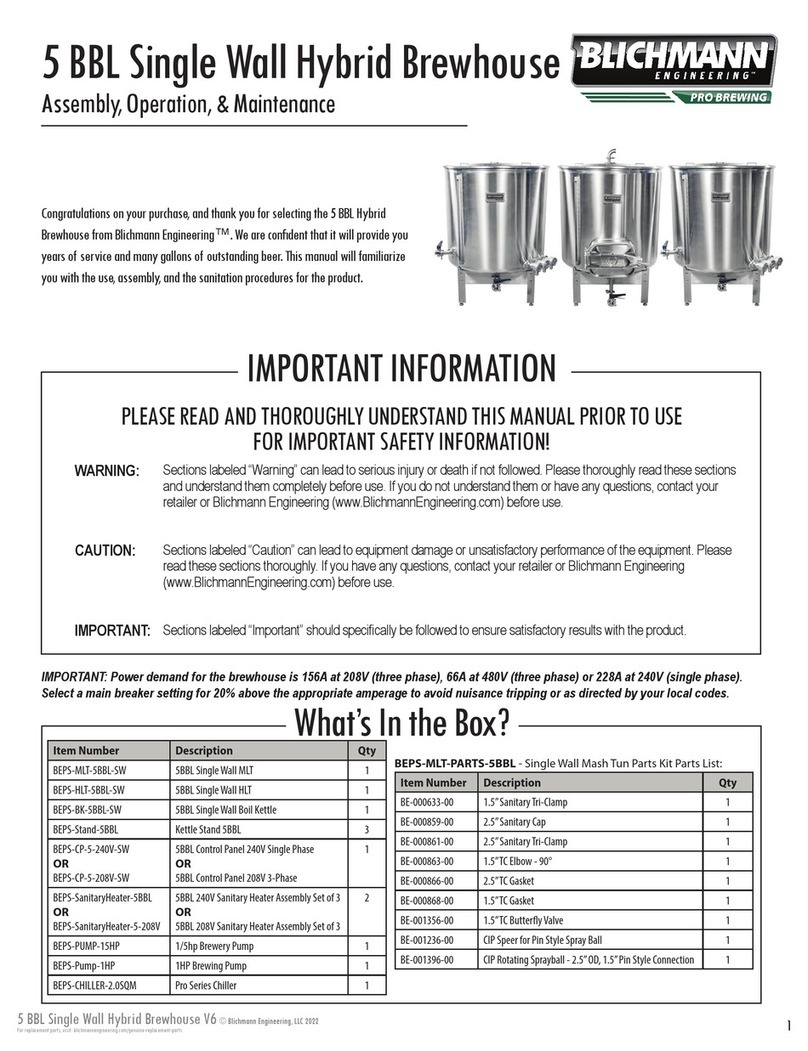
Blichmann Engineering
Blichmann Engineering BEPS-MLT-5BBL-SW Assembly operation maintenance

BROOD
BROOD DRNX SLM manual
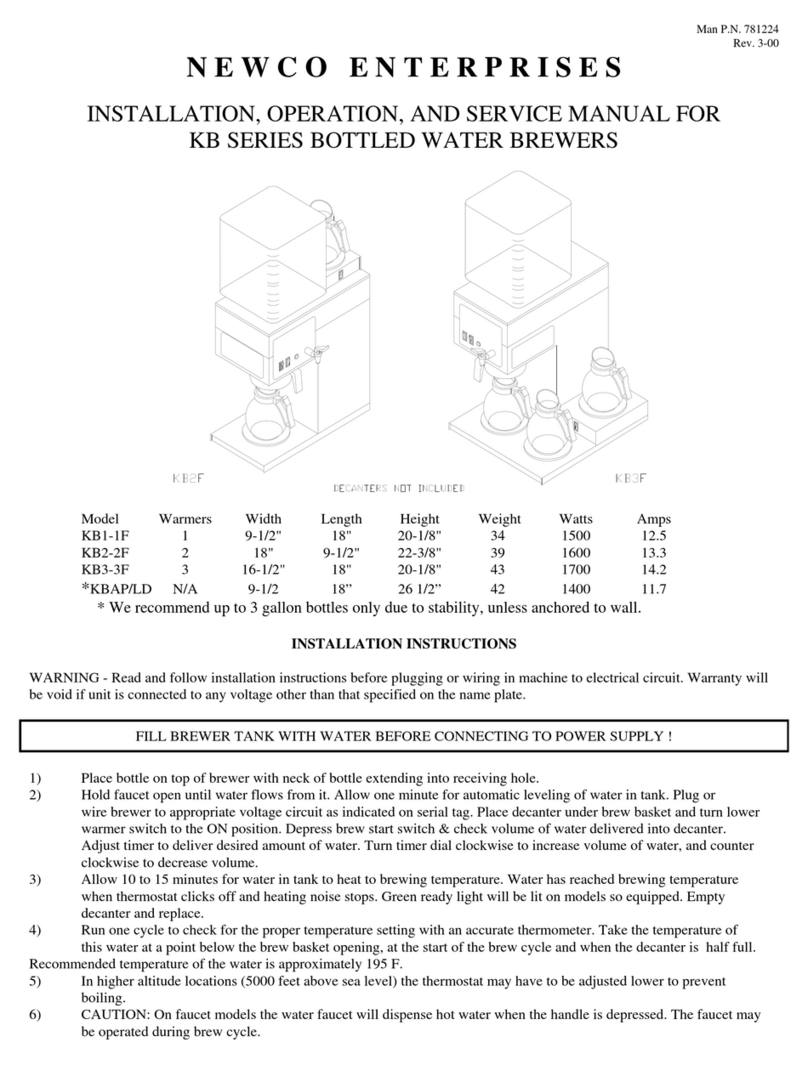
Newco
Newco KB Series Installation, operation and service manual
